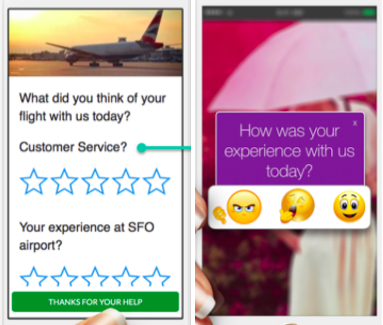June 9, 2016
Submitted by Swrve
Customer satisfaction is something that should be top of mind for all businesses. Loyal customers come about because they are happy with the entire experience of the service or the product that they are purchasing. Given how difficult it is to retain and monetize users, measuring this level of satisfaction is often a priority for the company. Now the only question is- how do you go about measuring this?
In a marketplace as competitive as this one, it’s only by listening carefully to your customers that a business delivers real competitive advantage. From app ratings to net promoter scores (NPS), they are the ones who have the real say when it comes to changes that need to be made. It is vital to know what you’re customers are thinking about your app and your service as a whole.
NPS, for example, is a smart way to determine the overall health of the business. By asking the simple question ‘Would you recommend this service to your friends?’, it is possible to get a real read on how well you are performing. That’s why so many organizations are so keen on this metric, and why it’s important to ensure your results are accurate.
But the rise of mobile presents both a challenge and an opportunity in this context.
Historically, surveys like these would have been carried out through snail mail, over the phone, or in more recent years via email. This just isn’t as effective anymore - largely because consumers no longer interact with brands in these channels.
The result is low response rates and incomplete data. Worse, it is often inaccurate as the survey itself is delivered at some remove from the actual experience itself, which is typically delivered via mobile.
A prime example of this ‘out with the old in with the new’ is the banking industry. According to BBA data, the majority of all banking interactions now take place on mobile, with only 15% being carried out in the physical branch. Furthermore, there’s over 30x more log-ins taking place on mobile than on desktop. What this means for banking institutions is that is banks want to run an NPS program, they’ll need to do so on the mobile app, not just in branch or on desktop.
As noted above, one consequence of the enthusiastic adoption of mobile apps by consumers is that they are rarely seen in the channels used to gather feedback. So it is necessary to accept that reality and develop a ‘native mobile’ approach to collecting and analyzing consumer satisfaction. But now to the opportunity: mobile delivers a myriad of ways to look for feedback when customers are both more responsive, and their responses are more accurate.
So, what exactly is it about the mobile app that makes it so effective? Here’s a few factors:
- Location - for example, when a user breaks a geo-fence or activates their device, we can have a very simple survey pop up via push notification.
- Real-time - we can send messages in real-time, and since most mobile users have their phone with them at most times, you can receive feedback in the same moment.
- Data - using in-app methods to collect opinions and data allows for a much more seamless analysis of the results
- Context - In apps, we know our users, we can follow their entire journey from the moment they install the app to the moment we’re measuring their satisfaction.
The traditional alternative to mobile measurement will arrive probably days after the service has been used or the purchase has been made. It could come in the form of an email that, in my case, will go straight into my promotions folder in my email account, and likely remain unread. By contrast mobile surveys are both immediate and ‘native’ to the consumer’s habits.
I want to close with one simple example of what I am talking about. In the travel industry, measuring customer satisfaction is key: how was the hotel stay, the flight, the booking experience and so on.
It is now possible to obtain this data via in-app surveys - as opposed to the clunky email survey that arrives in your inbox 2 weeks after your travel takes place. The illustrations below show tight, focused interactions that could take place just after the journey. In the context of a flight, for example, they could be delivered as the user breaks the geo-fence at the airport of arrival. They’re over within seconds, and provide incredibly valuable feedback, develop the relationship with the user, and gain loyalty and trust.

And the interaction rates for surveys like these are off the charts, with over 50% of people replying to them. That’s a huge step up from typical response rates of 2 or 3% delivered via other channels.
It’s very simple, and win-win. If people say they’re happy - that’s the end of the survey. But if they’re not happy, the conversation can continue until we find out the reason why. Meaning that, in real-time, the airline can find out which aspect of the experience the customer was unhappy with - and improve it right there and then.
If you're interested in learning more about how to deliver 'native' mobile customer surveys and feedback to optimize your business, you can watch our webinar on demand here.
